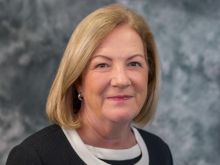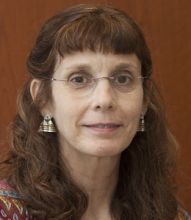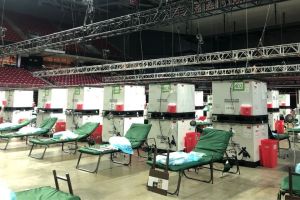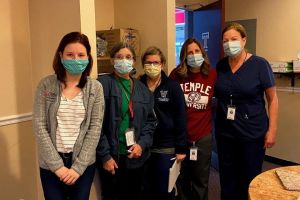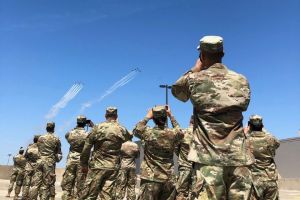Operation COVID

The arrival of the novel Coronavirus upended nearly every facet of daily life. Disruption caused by the virus inspired Widener faculty, students, and alumni across disciplines to contribute their talents and expertise to the ongoing response efforts.
An interdisciplinary team led by the School of Engineering jumped into the race to find an effective treatment to guard against COVID-19. Student-led research pivoted to focus on the pandemic’s impact on the stock market, chronic stress, local politics, and other areas. Alumni in a variety of industries rushed to the front lines to care for and serve some of the most vulnerable populations affected by the virus.
Leadership, compassion, and outreach are in our DNA at Widener.
It’s why when nursing graduate and board trustee Nancy Hesse ’80 received a call to be the chief nursing officer and assemble a team to lead Philadelphia’s emergency response to COVID-19, she didn’t hesitate to say yes.
“It was surreal,” said Hesse. “Some days I just had to pinch myself.”
A veteran emergency trauma nurse and health care executive, Hesse was tapped to lead on a collaborative task force and establish a field unit at the Liacouras Center in Philadelphia. The center was organized as a temporary surge facility for COVID-positive cases.
"This experienced pulled from all parts of my background, and I had to do it in 10 days’ time. Everything was accelerated,” said Hesse.
Almost as quickly as the virus descended upon Philadelphia, Hesse had to assemble a team to transform the 10,000-seat sporting arena into a full service 170-bed health care facility to offset the anticipated burden in Philadelphia’s hospitals.
“My first call,” she explained “was to Cathy Evans.”
Like-Minded People Working toward the Same Goal
Cathleen Evans ’07, ‘16, an assistant professor of nursing, is an expert in emergency management. In addition to work at Widener, Evans volunteers with the National Disaster Medical System (NDMS) and has served on a number of deployments throughout the United States to bring emergency relief to areas hardest hit by disaster.
“Everything that I’ve done in my career – for my dissertation, for my education – has always had one thread holding to the recognition that disaster could rear its ugly head at any time,” said Evans.
Evans deployed with the Philadelphia Medical Reserve Corps along with Hesse, her high school classmate and former colleague at Abington Hospital Emergency Trauma Center, to guide efforts to implement operational processes, establish patient safety protocols, and train collaborative teams.
"This was starting literally from ground zero." —Cathy Evans
Philadelphia joined a roster of metropolitan cities across the country like Seattle, Miami, and Chicago that opened surge COVID units. The pop-up facilities came in response to early projection models that predicted a shortage of hospital beds and equipment.
Overseen by Philadelphia’s Office of Emergency Management and Department of Public Health, and with support from the Federal Emergency Management Agency (FEMA) and the Department of Defense (DOD), the facility was designed to care for COVID-positive patients in isolated recovery. Its creation helped manage capacity in intensive care units (ICU) and emergency departments.
Nearly 300 volunteers from the Philadelphia Medical Reserve Corps, local and regional health systems, as well as outside vendors and agencies staffed the site. Despite the varied experience and expertise on hand, the facility’s objective faced an uphill battle exacerbated by limited time and resources.
“It was everything from setting up phones to how we deal with hazardous waste, how do we deliver medication to the patients, and how do we store medication,” said Hesse.
In a few weeks, the volunteer staff repurposed the iconic sporting arena into a fully operational health care facility. From respiratory therapy and radiology, to EKG testing and physical therapy, the center offered on-site access to critical services. Within each team, Hesse and Evans worked hands-on to provide leadership and guidance to ensure everything operated cohesively and efficiently.
“When you have an operation like that, you have to think in multiple dimensions all at the same time, and one person cannot do that,” said Evans.
Fighting an Invisible Threat
Normally, when an emergency response plan is activated, operations hinge on a central mission and have an identifiable cause of destruction, such as the aftermath of a natural disaster. At the time of the facility’s construction, scientific data on COVID-19 was still forthcoming, leaving Hesse and Evans to face an unfamiliar danger.
“The Liacouras mission was different because we had an unknown antigen, we also had an unknown environment, which we knew was austere, and we were building it from scratch,” Evans explained.
Limited knowledge of COVID’s origins, transmission, and potential treatment compounded the site’s operational logistics. Additional levels of caution were needed to prevent further spread and protect those within the facility.
“Everything had to be looked at, scrutinized, tested, and figured out,” Evans said.
Uncertainty surrounding the amount of available personal protective equipment (PPE) further stressed the situation. The highly contagious nature of the virus meant that PPE would play a significant role in every step of the unit’s operations.
Gretchen Bernatowicz ‘06, a family nurse practitioner program graduate, joined the site’s Infection Prevention and Control team, which managed the PPE.
"It was one of the best things I have ever done in terms of learning and being a part of something so groundbreaking.” —Gretchen Bernatowicz '06
Whereas traditional health systems have robust stocks of PPE and dedicated policies surrounding its use, the makeshift hospital lacked an inventory system, policy guidelines, and decontamination capabilities.
“We needed to figure out how PPE was going to be used and how we were going to preserve our supply. Reuse and reprocessing became a big part of our work,” said Bernatowicz, who works as a nurse practitioner at Villanova University.
She collaborated with different teams and nurse leaders, including Evans, to streamline the procedures for reprocessing and decontaminating equipment, such as face shields and goggles, for reuse. According to Evans, of the approximate 300 staffers on site, “nobody tested positive in the timeframe that we were there, so we felt confident that we protected our staff with the highest level of PPE possible.”
Bernatowicz credits the clinical and research experience gained at Widener for informing her assignment in the facility. While she wasn’t working in a patient-facing role, Bernatowicz drew upon comprehensive clinical and evidence-based skills to secure safety protocol.
“Having the knowledge as a nurse practitioner made me more helpful in terms of infection control, making sure that staff and the patients stayed safe,” said Bernatowicz.
Prepared for What Comes Next
On April 28, 2020, nearly two weeks after the facility opened, the Blue Angels flew over Philadelphia to honor and thank front-line workers. Among their audience were facility staff who stood at attention on the Liacouras Center roof.
The event brought a moment of pause for Hesse and Evans to realize the magnitude of the operation and its impact on Philadelphia and the surrounding region.
"Bringing everyone together to support a need in the city of Philadelphia was humbling. I felt so honored to be serving our city next to these service men and women, excellent clinicians, and volunteers.” —Nancy Hesse
Their efforts were instrumental in positioning Philadelphia to respond to the shifting effects of COVID. As public health officials warn of a second wave of cases, the Liacouras Center serves a framework for the action and management plan of future field sites, should they be warranted.
For Evans, this latest deployment underscored the transformative and lifesaving work of nurses, especially in the most trying of times.
“As nurses, we’re on the front line. People look to us to take care of them, to have the answers, and to keep them safe and cared for. I’m grateful to have been a part of that,” said Evans.
